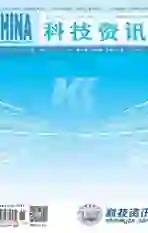宽光谱高效硅基薄膜太阳电池的基础研究报告
2016-05-14赵颖许盛之张晓丹刘伯飞王利
赵颖 许盛之 张晓丹 刘伯飞 王利
摘 要:介绍高绒度 MOCVD-ZnO:B 透明导电薄膜用作非晶硅太阳电池前电极、非晶硅太阳电池BZO/p-a-SiC:H接触特性改善、非晶硅界面缓冲层对非晶硅锗电池性能的影响以及非晶硅锗电池性能的调控等方面的研究内容及结果。 首先我们将自行研制的具有优异陷光效果的掺硼氧化锌 BZO 用作 p-i-n 型非 晶硅太阳电池的前电极,并且将传统商业用 U 型掺氟二氧化锡 FTO 作为对 比电极。结果表明相对 FTO 电池,尽管 BZO 电池的电流优势明显,但当本征 层厚度较薄时其 Voc 和 FF 却较差。原因是相对于表面较为平滑的 FTO,BZO 表面呈大类金字塔的绒面结构会在本征层生长过程中触发阴影效应,形成大量的高缺陷材料区和漏电沟道,进而恶化电池的Voc和FF。在不修饰 BZO 表面形貌的情况下,通过调节非晶硅本征层的沉积温度来消弱 BZO 高 绒度表面引起的这种不利影响,改善后的电池 Voc 和 FF均有提升。在仅有 Al背电极的情况下,当本征层厚度为 200nm 时,BZO 前电极非晶硅太阳电池效率达 7.34%。 其次,我们采用重掺杂的p型微晶硅来改善前电极掺硼氧化锌(ZnO:B)和窗口层p型非晶硅碳(p-a-SiC)之间的非欧姆接触特性。通过优化插入层p型微晶硅的沉积参数(氢稀释比H2/SiH4、硼掺杂比B2H6/SiH4)获得了较薄厚度下(20nm)暗电导率高达4.2S/cm的p型微晶硅材料。在本征层厚度约为150nm,仅采用Al背反射电极的情况下,获得了效率6.37%的非晶硅顶电池,开路电压Voc和填充因子FF均较无插入层的电池有大幅提升。 第三,采用射频等离子体增强化学气相沉积(RF-PECVD)技术,进行了非晶硅锗薄膜太阳电池的研究。针对非晶硅锗薄膜材料的本身特性,通过调控硅锗合金中硅锗的比例,实现了对硅锗薄膜太阳电池中开路电压和短路电流密度的分别控制。借助于本征层硅锗材料帯隙梯度的设计,获得了可有效用于多结叠层电池中的非晶硅锗电池。 最后,介绍了针对非晶硅锗电池本征层高锗含量时界面带隙失配以及高界面缺陷密度造成电池开路电压和填充因子下降的问题,通过在P/I界面插入具有合适带隙的非晶硅缓冲层,不仅有效缓和了带隙失配,降低界面复合,同时也通过降低界面缺陷密度,改善内建电场分布从而提高了电池的收集效率。进一步引入I/N界面缓冲层以及对非晶硅锗本征层进行能带梯度设计,在仅采用Al背电极时,单结非晶硅锗电池转换效率达8.72%。 总之,通过以上优化措施,最后获得了效率为14.06%的非晶硅/非晶硅锗/微晶硅三结叠层太阳电池。
关键词:三结叠层 薄膜 太阳电池 非晶硅 非晶硅锗 界面缓冲层
Abstract:We report our work and result on (1) MOCVD-ZnO:B front contact with high haze in amorphous silicon thin film solar cells , (2) the contact property between BZO and p-a-SiC in amorphous silicon solar cells , (3) Effect of a-Si:H Interface Buffer Layer on the Performance of Hydrogenated Amorphous Silicon Germanium Thin Film Solar Cell and (4) Modify the Performance of Hydrogenated Amorphous Silicon Germanium Thin Film Solar Cell First, Boron doped zinc oxide (BZO) deposited by metal organic chemical vapor deposition(MOCVD) is used as front contact in amorphous silicon thin film solar cells. When the intrinsic a-Si:H layer thickness is changing, the performance of the solar cells show different evolution trend. In order to eliminate this negative effect, we increase the deposition temperature of intrinsic a-Si:H layer to optimize the open circuit voltage and fill factor. Second, High conductivity p-type microcrystalline silicon film was inserted between front contact (ZnO:B) and windows layer(p-a-SiC) in order to overcome the non-ohmic contact. Without ZnO back reflection, the conversion efficiency of p-i-n type amorphous silicon solar cells is 6.37% and the thickness of intrinsic layer used in this amorphous silicon is only 150nm. Compared with the solar cells without p-type microcrystalline silicon interlayer, the open circuit voltage(Voc) and fill factor(FF) were largely improved. Third, the insertion of a-Si:H buffer layer with proper band gap into P/I interface not only mitigates band gap discontinuities and interface recombination, but also improves the electric field distribution by decreasing the defect densities at P/I interface, thus the collection efficiency of a-SiGe:H solar cell is elevated. By inserting a-Si:H buffer layer into I/N interface and designing band gap profiling along the a-SiGe:H intrinsic layer further, the 8.72% conversion efficiency of single junction a-SiGe:H solar cell is achieved when only Al back reflector is added as back contact. Forth, we studies hydrogenated amorphous silicon germanium thin film solar cells. By means of the structural design of band gap profiling in the amorphous silicon germanium intrinsic layer, hydrogenated amorphous silicon germanium thin film solar cells. As far as the best cell prepared in out lab, the a-Si:H / a-SiGe:H /μc-Si:H was used, and efficiency of 14.06% was got by matching the currents of three cells.
Key word:Three juction;Thin film;solar cell;amorphous silicon;Amorphous Silicon Germanium;interface buffer lyaer
阅读全文链接(需实名注册):http://www.nstrs.cn/xiangxiBG.aspx?id=50376&flag=1
